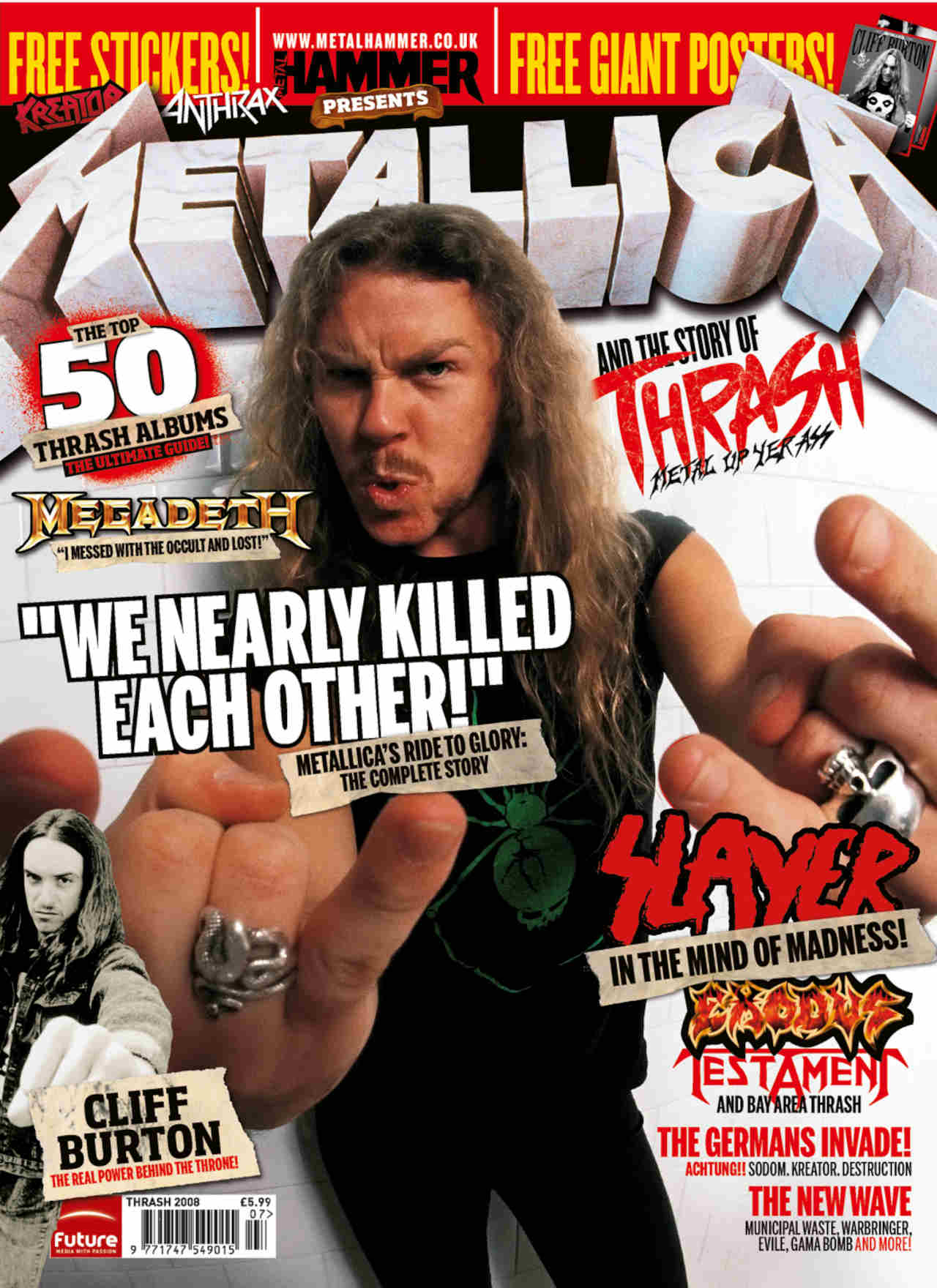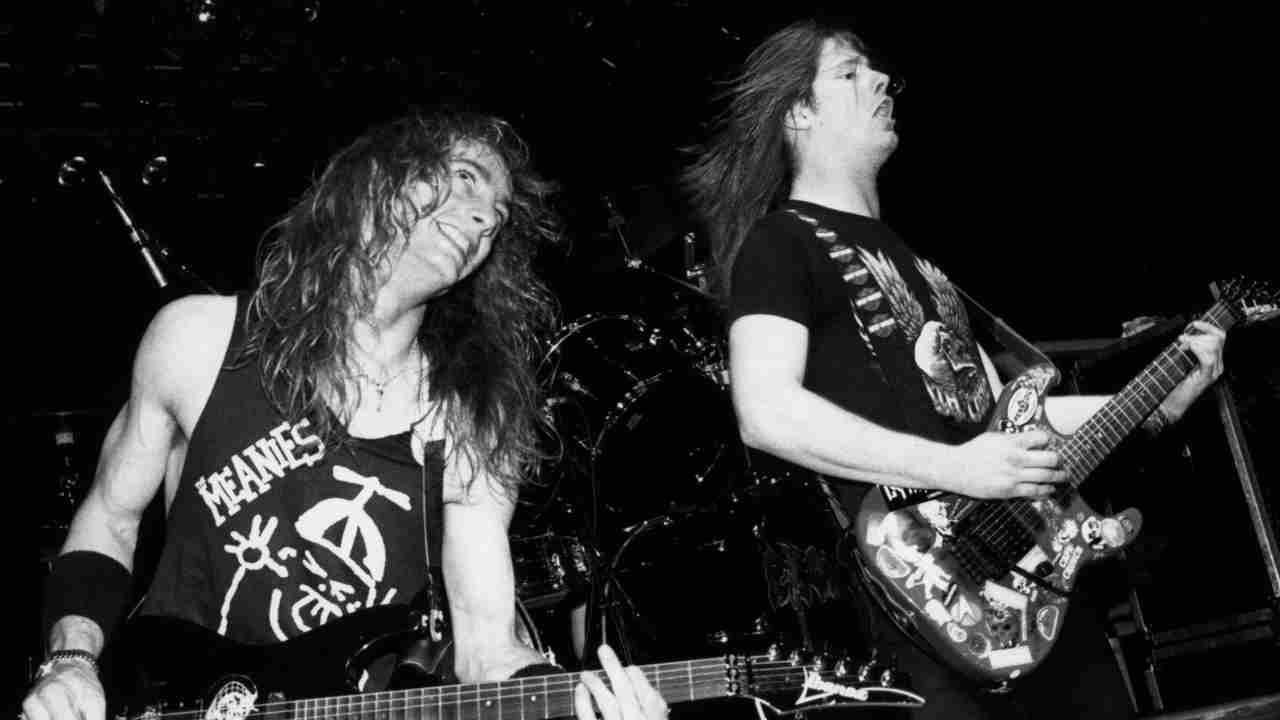Phil Kettner remembers the primary time he noticed Metallica dwell. “My first response was, ‘Oh wow, it’s punk rock with lengthy hair,’” says Kettner, who was guitarist with San Francisco proto-thrashers Lääz Rockit on the time. Kettner’s personal band had been tipped because the Bay Space’s subsequent huge factor, however this was one thing utterly new.
Metallica performed their first present in San Francisco at The Stone in September 1982. Inside just a few months, they’d relocated to the the town from their native LA, recruiting bass wunderkind Cliff Burton the method. A model new scene shortly grew up round them, and the Bay Space turned the epicentre of the quickest, loudest, heaviest music on the planet: thrash steel.
“‘Thrash’ wasn’t used that a lot as a time period in 1982,” says Ron Quintana, one of many architects of the Bay Space thrash scene. Quintana was the editor of the seminal Steel Mania fanzine, which exhaustively lined the San Francisco steel and punk scenes in a rage of caustic humour, slapdash cut-and-paste layouts, and inky newsprint. He was additionally a DJ at KUSF, a community-run radio station that operated out of the College of San Francisco. “I believe it was extra in 1984, with speedsters like Exodus, Slayer, Possessed, and Suicidal Tendencies, that we referred to as them thrash and never simply steel or punk.”
No matter what it was referred to as in its infancy, the sound produced by these early San Francisco bands was like nothing ever heard earlier than. Younger, fleet-fingered savages like Metallica, Loss of life Angel, Exodus, Lääz Rockit, Possessed, Blind Phantasm and a handful of others had been pushing musical boundaries, enjoying sooner and with extra intricacy then appeared humanly potential.
There have been a myriad of locations for these bands to play everywhere in the metropolis, at now-infamous golf equipment like Ruthie’s Inn, Kabuki Theatre, The Fillmore, The Keystone, The Stone and The Mabuhay Gardens, which was host to the equally envelope-pushing hardcore punk scene. There have been file shops and hangouts, a wholesome school radio scene and a smattering of enthusiastic fanzines protecting all of it. So how did this occur? Was it the work of perpetual schemer Lars Ulrich and his assortment of Angelwitch imports, as is usually reported within the annals of steel?
“[SF radio stations] KUSF and KALX had been enjoying excessive steel in 1982, so NWOBHM was outdated hat by the point,” says Quintana. “Lars and firm might play two Diamond Head and one Blitzkrieg music at any viewers, however there have been two wonderful file import shops and tons of Tower LP shops supplying the maniac habits of followers.”

“The impartial file shops had been nice,” says Rob Cavestany, guitarist and co-founder of Loss of life Angel, one of many first and absolutely the youngest of the Bay Space thrash bands. “There was the Document Trade and the Document Vault. These had been the primary outlets, the place all of the metalheads would come down and discover the most recent new releases and listen to concerning the newest bands. This was even earlier than Metallica, once we had been first listening to about bands like Tygers of Pan Tang, Loundness, Riot. These had been the bands we had been tripping on.”
Issues modified drastically, nonetheless, as soon as Metallica got here to city. “I don’t know precisely after they fashioned in relation to once we did,” says Cavestany, “however I do know they made a wave faster than we did, we had been means into them, and had been very influenced by them. We noticed them play on the Keystone in Berkeley, and it was an eye-opening night, for certain.”
“The exhibits had been at all times completely packed,” provides Kettner. “There have been lots of bought out exhibits again then. On the time, we had a supervisor who was very tenacious about getting out-of-town bands to play. We truly introduced Metallica as much as play their first present on the Outdated Waldorf. We did a well-known present again in 1983 with Metallica headlining. We supported them, and Exodus opened up. That was at The Stone.”
“There have been lots of future musicians in these crowds,” remembers Quintana. “However there have been numerous every type, even posers.”

“We performed with Metallica for the primary time on the Kabuki Theatre,” says Cavestany. “It was with Metallica and Armored Saint. However we’d been enjoying for years earlier than that. We began enjoying out in 1982. I used to be about 13, 14 years outdated on the time. Andy [Galeon, Death Angel drummer] was about 9 or ten. I imply, we had been very younger. However there have been all-ages golf equipment occurring, there have been events, issues like that we performed. And the opposite instances, when there was some form of age restriction, they principally simply snuck us in. We performed with Exodus, Legacy – who later turned Testomony – Slayer, Megadeth, Mercyful Destiny, Lääz Rockit. And we performed with all of the punk bands as properly.”
Punk Rock was alive and properly in San Francisco in 1982, though not the entire steel bands on the town embraced it. “It was fairly segregated,” says Kettner. “I’m certain there have been individuals from each these scenes that went to totally different exhibits however we didn’t e book any exhibits with, like, Black Flag or TSOL. We by no means booked exhibits with these guys, which I remorse, as a result of I believe it might have opened individuals’s eyes. That’s the place the thrash factor got here from, it crossed over from the punk ingredient. Contemplate the circle mosh and stage diving and stuff like that – that got here immediately from the punk scene.”
In contrast to Lääz Rockit, Loss of life Angel dived headfirst into the metal-punk crossover motion. “We performed with lots of punk bands,” says Cavestany. “That’s how the crossover factor took place, actually. We performed exhibits with Cro Mags, GBH, DRI, Verbal Abuse, Suicidal Tendencies, DR. Know – we performed with these guys on a regular basis.”
“Poor LA music followers had solely hair bands or punk exhibits, there was no crossover,” says Quintana. “However punks up north went to steel exhibits, and vice versa. In LA, hardcore punk exhibits had been extraordinarily violent. Suicidal Tendencies couldn’t even play their hometown. They needed to come up north to play. That crossover created numerous good, normally pleasant competitors within the Bay Space.”
By the mid Eighties, the punk affect on the San Francisco steel scene was embraced and championed. However the glam bands? Not a lot. “We knew lots of youngsters again then who had been actual adamant about the entire ‘Bang the top that doesn’t bang’ factor,” says Kettner.

“There have been glam bands in SF, and a few of them had been cool guys,” explains Cavestany. “You bought Jetboy, Sea Hags, Useless. Davey Useless truly produced our album, Frolic By way of The Park (1988). We performed exhibits with a few of them within the early days, till thrash acquired the ‘kill poseurs’ vibe, after which the traces of separations occurred, the place these youngsters wouldn’t be caught lifeless at one among our exhibits.”
“Like rats, glam was all over the place,” snarls notorious poseur-hater Quintana. “Van Halen was king and even clone bands had huge followings, too.”
Exodus, arguably probably the most musically violent band within the Bay Space thrash motion, had been additionally probably the most vocal of their hatred of fishnet-wearing glam-rockers, usually calling for his or her followers to “Kill the poseurs”, wherever they could be discovered. As such, SF thrash exhibits usually devolved into mayhem.
“There was violence occurring within the viewers, for certain,” says Kettner. “Individuals had been throwing one another round, however then you definately’d exit for a beer afterwards. I’m certain there have been just a few those who had been identified for not becoming in throughout the scene, or for making an attempt to behave like one thing you’re not, and people individuals would probably be ostracised and/or crushed within the alley. However I wasn’t witnessing that.”
“It was actuality, although,” says Cavestany. “Poseurs did get their asses kicked. Don’t let [original Exodus singer Paul] Baloff catch one among them round.”
“We did get very wild and loopy at factors,” says Kettner. “I’m probably not certain how to take a look at all that as a result of on the one hand, yeah, it was loopy and aggressive, however there was lots of camaraderie on the identical time. I simply bear in mind considering, ‘Why aren’t we getting arrested?’”

By the late Eighties, when Metallica, Slayer, and Megadeth had all graduated to arenas, SF thrash started to mutate into totally different, much less punk-derived strains. Second-wave thrash bands like Testomony and Machine Head added their very own twists, from progressive parts to ‘groove’ into the combination. The unique wave of bands had been both millionaires, cult heroes, or on their final legs. After which the golf equipment began to go up in smoke.
“They closed the Kabuki Theatre,” sighs Kettner. “That place was wonderful, this big outdated theatre. I bear in mind seeing Metallica supporting Raven there, Mercyful Destiny… If you went to a present there, you realised simply how huge this factor was actually changing into. I believe that’s kinda what killed the scene, within the later 80s and early 90s. The Keystone Berkeley burned down, Wolfgang’s burned down, The Stone burned down…”
“Bands and scenes are cyclical, and being a quite small metro space, Bay Space thrash bands both acquired signed, moved on, broke up or mutated,” says Quintana. “And few might substitute that authentic vitality and energy.”
Initially revealed in Steel Hammer Presents Metallica And Thrash Steel, July 2008

